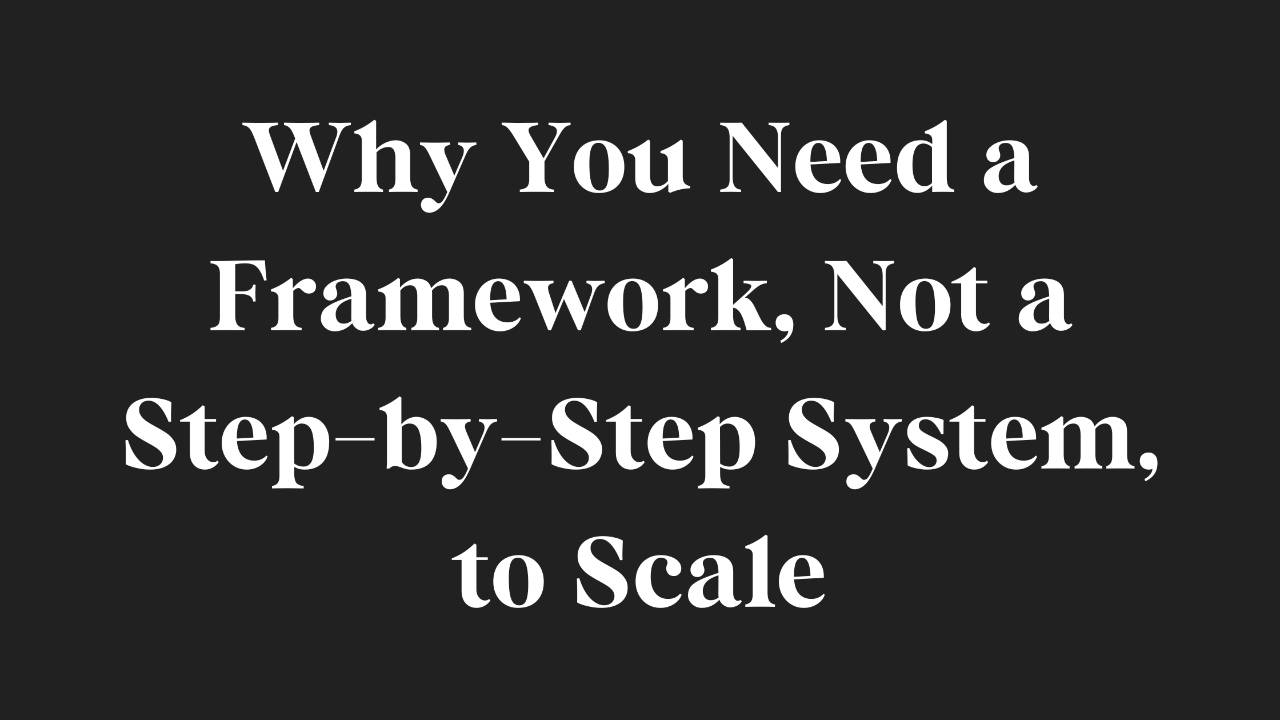
Why You Need a Framework, Not a Step-by-Step System, to Scale
Scaling a business is often painted as a linear process. Step one, step two, step three—voilà, success! But real business growth is anything but linear. It’s messy, nuanced, and full of pivots, surprises, and lessons you didn’t see coming. That’s why a rigid step-by-step system often falls short.
Instead of trying to cram your business into someone else’s blueprint, it’s time to embrace a framework—a proven structure that guides you while leaving room for customization, creativity, and growth. Frameworks offer the best of both worlds: the clarity of a system and the flexibility to adapt it to your unique vision, clients, and goals.
So, let’s explore why a framework is the ultimate tool for sustainable scaling and how to create one that aligns with your business.
Frameworks vs. Step-by-Step Systems: What’s the Difference?
Let’s start by clearing up a common misconception: a framework isn’t just a fancy word for a system. While systems are often rigid and prescriptive, frameworks are flexible and adaptable.
A step-by-step system might tell you exactly what to do, when to do it, and how to do it. Sounds great, right? Until you hit a roadblock that doesn’t fit neatly into the system’s structure. Or until your business evolves and the system no longer serves you.
A framework, on the other hand, provides structure without rigidity. It’s a guiding set of principles, steps, or stages that you can adapt to your needs. Think of it as a toolkit rather than a recipe. Instead of following instructions to the letter, you have the freedom to use the tools in a way that works for you.
The Benefits of a Framework for Scaling
So, why should you ditch the cookie-cutter systems and embrace a framework instead? Here’s why:
Flexibility to Pivot
No two businesses are the same, and neither are their scaling journeys. A framework allows you to pivot and adapt as your business grows. Whether you’re launching a new offer, exploring a different marketing strategy, or navigating unexpected challenges, a framework gives you the flexibility to make changes without derailing your progress.
Alignment with Your Vision
A step-by-step system often assumes that success looks the same for everyone. But your vision is unique. A framework allows you to build a business that aligns with your values, goals, and lifestyle. It’s not about fitting into someone else’s mould—it’s about creating a path that feels true to you.
Empowerment, Not Dependency
Step-by-step systems can leave you feeling dependent on the system’s creator. What happens when the system doesn’t account for your specific needs? With a framework, you’re in the driver’s seat. It empowers you to make decisions, trust your intuition, and take ownership of your growth.
Scalability and Sustainability
A rigid system might work for a while, but it can quickly break down as your business scales. A framework, on the other hand, is designed to grow with you. It supports sustainable scaling by focusing on principles and processes that can evolve alongside your business.
How to Create Your Bespoke Framework
Ready to ditch the cookie-cutter approach and design your own framework? Here’s how to get started:
1. Start with Your Vision
Your framework should align with your long-term vision for your business. What are you building? What impact do you want to make? What does success look like for you? Use your vision as the foundation for your framework.
2. Map Your Client Journey
Your framework should guide your clients from where they are now to where they want to be. Think about the transformation you deliver. What are the key steps or stages in that journey? How can you create a framework that supports your clients at every stage?
3. Focus on Principles, Not Rules
A good framework is rooted in principles rather than rigid rules. For example, instead of saying, “Post on Instagram three times a week,” your framework might focus on the principle of consistent, value-driven content creation. This approach leaves room for personalization while still providing guidance.
4. Keep It Simple
The best frameworks are simple and intuitive. If it feels overwhelming, it’s not a framework—it’s a system in disguise. Aim for clarity and ease. Your framework should feel like a helpful guide, not a set of constraints.
5. Test and Refine
A framework isn’t set in stone. It’s a living, breathing tool that evolves with your business. Test it, tweak it, and refine it based on what works and what doesn’t. Your framework should grow and adapt just like your business does.
Scaling your business with a framework, rather than a step-by-step system, gives you the flexibility, alignment, and empowerment you need for sustainable growth. Frameworks adapt to your unique vision, support your clients’ journeys, and evolve alongside your business. By creating a bespoke framework that works for you, you can build a high-performing business that feels aligned, authentic, and totally yours.
STAY CONNECTED
Join our mailing list for latest news and updates.
Your information is safe with us.



